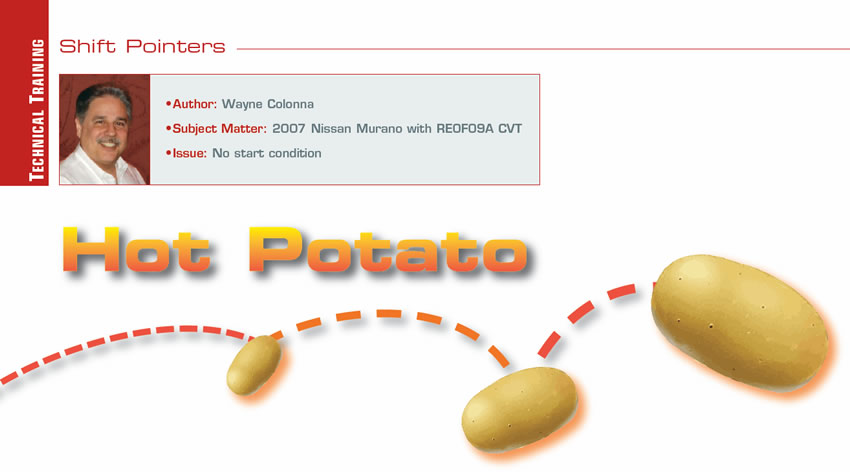
Shift Pointers
- Author: Wayne Colonna
- Subject Matter: 2007 Nissan Murano with RE0F09A CVT
- Issue: No start condition
After vehicle tossed from one shop to another, TCM replaced and vehicle returned to owner.
The idiom “hot potato” is not new to many folks, and in fact many have been participants of a hot potato scenario of one kind or another. Here is one that began with an engine replacement and ended with needing a TCM (Transmission Control Module).
A 2007 Nissan Murano using an RE0F09A CVT had its 3.5L engine changed, which resulted in a no start condition. The general-repair shop that did this work was unable to determine why and so replaced the ECM in an attempt to fix the problem. This too did not resolve the issue. The vehicle was then brought to an entirely different repair facility to sort out the problem. This particular facility somehow found a way to bypass the immobilizer system, which did allow the vehicle to start. After a short run on the lift it was noticed that the transmission wasn’t changing ratios. The TCM was checked for codes and found a vehicle speed sensor code P1720, a P1574 code for the ASCD vehicle speed sensor and TCC slip code P0744. The car was then put on a flat bed and brought to a transmission shop to handle the next phase of problems that were not there originally. This is when the call came in to
ATSG.
Having dealt with these codes before, we asked the technician to erase the codes and drive the vehicle on the ground and not on the lift. As suspected those three codes did not return. The reason is the ECM receives two vehicle speed signals through the CAN BUS communication line. One signal comes from the ABS system while the other comes from the TCM. All four wheels need to be on the ground for these two speed signals to agree. When they are not, P1720 says the vehicle speed from the TCM is out of range with the vehicle speed coming from the ABS (P1574). The result of these two codes being set will produce P0744.
Once the vehicle was driven on the road these codes did not return as they were falsely set being driven on the lift. But the transmission was still not changing ratios. The TCM was checked for codes and there were none. The ECM was then checked for codes and four were found. A P0840 for the transmission fluid pressure sensor A (secondary pulley pressure), a P0845 for the transmission fluid pressure sensor B (primary pulley pressure), a P1715 for an input speed sensor/primary pulley speed sensor malfunction and a P1778 for a stepper motor malfunction.
What was odd about this is the only way the ECM could have a stepper motor code, and input speed sensor code, and both pulley pressure sensor codes is for the TCM to have reported it over the network. Yet the TCM did not have the codes nor was it controlling the transmission. After verifying that the TCM had good power and grounds circuits, it was suggested that the TCM was bad and needed to be replaced. This decision was made as the TCM had no codes and is directly responsible for changing the ratio of the transmission. Yet the TCM was broadcasting error codes to the ECM. Once the TCM was replaced, the transmission worked as designed.
Aside from the immobilizer issue, this hot potato finally cooled off and the owner had his vehicle back.

Wayne Colonna is president of the Automatic Transmission Service Group (ATSG).













